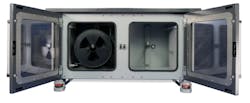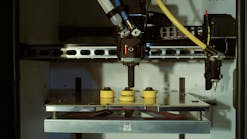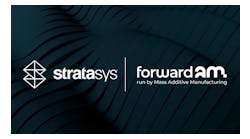Printing's advantages shine in pandemic, says 3DChimera co-founder
Watch for our Cover Story focusing on innovations in additive manufacturing, coming in the May issue and on plasticsmachinerymanufacturing.com.
By Karen Hanna
In a year that required quick adaptation, one of the chief selling points of additive manufacturing — its flexibility — really shone, said Alex Hussain, CEO and co-founder of 3DChimera, a supplier of all things 3-D.
According to Hussain, Fortune 100 companies — among 3DChimera’s biggest customers — withdrew their investments in 3-D printing technology when the pandemic hit. But smaller companies stepped into the gap, looking for ways to fabricate parts that suddenly were hard to source. For them, 3-D printing offered a lot of benefits.
Along the way, like so many individuals over the past year, many companies found themselves picking up extra projects to insulate themselves from the unpredictability in the economy. Using 3-D scanners and printers, customers could fabricate parts and respond to needs in the supply chain.
Interest in 3DChimera’s products and services came from firearms makers, as well as manufacturers of medical devices and consumer and pet-care products. For many of 3DChimera’s new customers, supply chain problems meant returning to the drawing board, to make parts that are typically injection molded.
“And, so, we started to see a really quick transition to almost reshoring of manufacturing, but almost in a really strange way,” Hussain said.
In the last several months, 3DChimera has announced it’s a U.S. distributor for two new complementary technologies: innovatiQ’s TiQ 5 fused-filament-fabrication (FFF) printer, which began shipping this spring, and the MiQ 5, a filament dryer. InnovatiQ introduced both technologies in the fall during the virtual-only Formnext.
“This results in improved process reliability, making the TiQ 5 ideal for printing small series parts in industrial production,” Hussain said.
Like the TiQ 5, the MiQ 5 is especially appropriate for use in printing small-batch, industrial-use parts. It feeds material into the printer at the optimum temperature and humidity, and it uses colored lights to signal to operators whether conditions are in or out of spec.
Hussain said the pandemic has driven demand from some corners for 3-D printing technologies, accelerating a trend that’s been fueled by the technologies’ versatility, increasing user-friendliness and falling prices.
Typically, companies have used polyamide (PA) 12, which has a nice surface finish and can be easily dyed black. But also on trend are tough materials, like carbon- and glass-fiber-reinforced resins, Hussain said.
“And those also have similar characteristics to the PA 12, nylon from SLS [selective-laser-sinter printing], but they're typically printed instead in an FFF or FDM [fused-deposition-modeling] process, so extrusion-based 3-D printing. And in those cases, you can end up with incredibly strong and stiff parts,” he said. “And with minor CAD tweaks, you can easily replace parts that might have traditionally been made out of aluminum, or maybe a traditional polymer like an ABS or polycarbonate; we can print those things directly in 3-D printing.”
While companies might get their 3-D printing start by using the printing services of partners such as 3DChimera, many quickly find ways to justify investing in the technologies themselves. In part, that’s because the technologies are available across a wide range of price points, making it easy to enter the market, or to scale up as small-batch jobs take on greater importance.
“Our 3-D printers range from as little as 5,000 bucks, up to maybe 100K. Our average production 3-D printers, or manufacturing-quality 3-D printers, the price was right around $50,000. So you could bring in 10 or 20 of those machines, it would cost you less than an injection mold. One machine can make you 500 parts [in a production run], right? Twenty machines can make you 20 times that, and so that's where you start to see crazy efficiency come out of this equipment,” Hussain said. “One machine can allow you to accept small jobs you might have otherwise turned down, and many machines can allow you to potentially replace that previous production technology.”
Depending on the kind of printer, operators can print multiple parts on one machine, which is one way to compensate for the technology’s relatively slow production times. With no tooling, and print and design software increasingly targeting novice users, setup is easy, and many printers can run without human interaction — even overnight.
In this way, small batches that are economically unfeasible for injection molders become important side hustles for manufacturers with a few printers, allowing them to “open up totally new lines of business,” he said. Now, instead of minimum jobs of 5,000 or 10,000 parts, they can profit from as few as 50.
“It seems that a lot of these folks had been hesitant about the technology over the years, maybe for fear of replacing the existing business that they do, and I think what they've discovered is that it's in no way a threat to their business, but rather a huge supplement to the type of work that they can accept,” Hussain said.
He added that unlike other manufacturing methods, 3-D printing can produce parts without wasting material. Combined with the other advantages it offers — including the abilities to produce fine details and lattice structures, as well as to customize and tweak parts from one part to the next — printing just might be crossing a threshold, from novelty to manufacturing staple.
It's definitely changing the way some manufacturers operate, Hussain said.
“And I think that's been probably the most exciting part of working in our space here over the last year or so is that we've seen large percentage of small- and medium-sized businesses completely changing the way that they operate and stepping into new areas of business, producing products on demand or in short-run production, using 3-D printing as the primary manufacturing methodology,” he said.
Karen Hanna, associate editor
Contact:
3DChimera, Miami, 786-701-0700, www.3dchimera.com
innovatiQ GmbH + Co KG, Feldkirchen, Germany, www.germanreprap.com
Vital Statistics
TiQ 5 3-D printer
| Build volume | 19.7 inches by 15.7 inches by 18.7 inches |
| Maximum resolution | To within 20 microns |
| Maximum extrusion temperature | 752 degrees Fahrenheit |
MiQ 5 dryer for 3-D printers
| Filament capacity for active printing | Two 4.6-pound spools |
| Storage capacity | Three 4.6-pound spools or four 2.2-pound spools |
Related stories
From prototypes to production, manufacturers harness evolving 3-D technology.
Rize executives say printing offers personalization at push of a button.
Stratasys to launch production-scale 3-D printers.
Industry survey finds use of AM is expanding beyond prototyping and R&D.
3YourMind sees a growing market for printing spare parts.
Jabil develops a new high-strength filament to meet customer demand.
Additive manufacturing grew in 2020 despite pandemic, says Wohlers Report.









